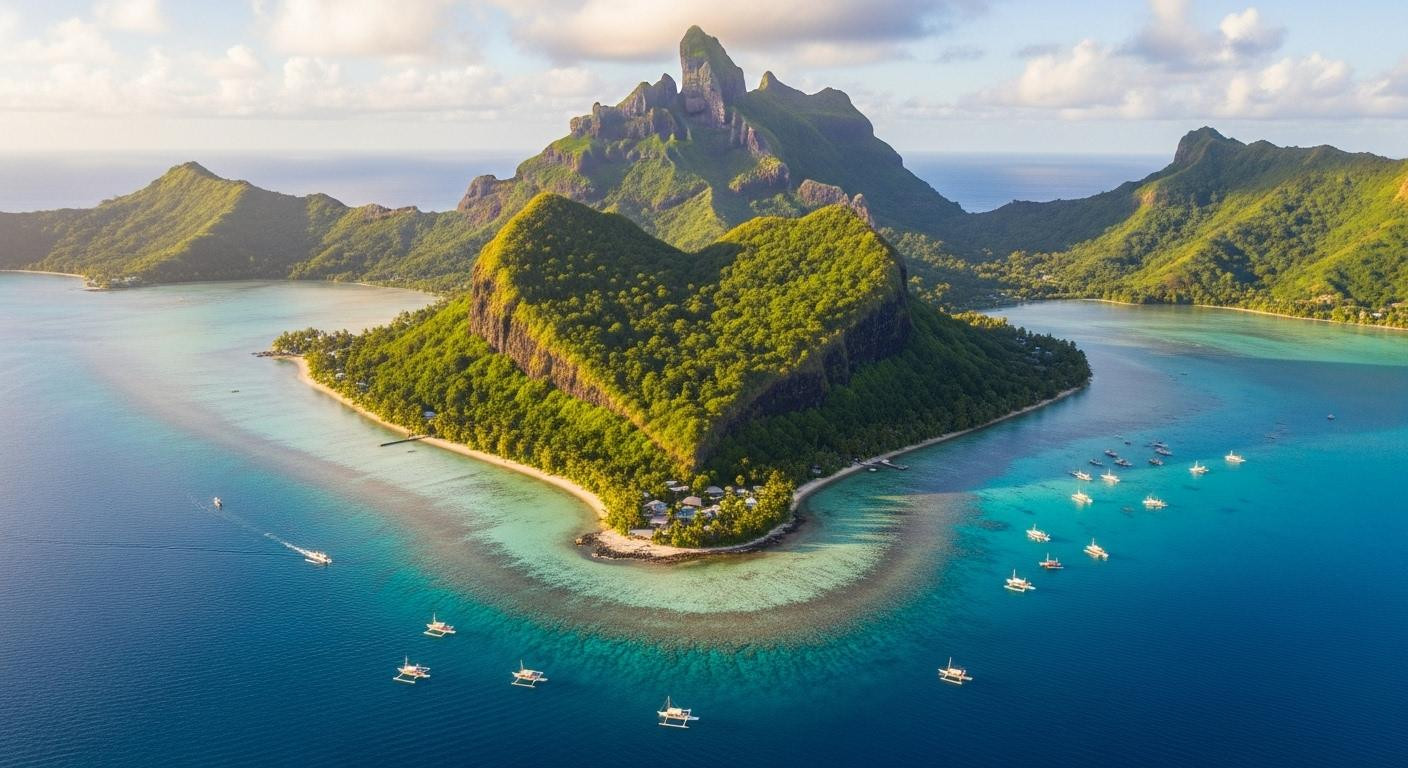Dawn breaks over Cook’s Bay at 5:48 AM, steam rising from my coffee as volcanic peaks catch golden light across an empty turquoise lagoon. The ferry from Papeete docked 30 minutes ago after a $34 ride that feels impossibly affordable compared to Bora Bora’s $380 flight requirement. Three days ago, French Polynesia meant $1,500 overwater bungalows and cruise ship crowds. Now, standing where 17,000 residents maintain fishing traditions while tourists sleep in resort bubbles, something fundamental shifts about accessible paradise.
The 30-minute ferry that changes everything
Moorea sits just 10 miles northwest of Tahiti, its heart-shaped silhouette spanning 52 square miles of volcanic drama. The Aremiti Ferry runs seven daily departures from Papeete to Vaiare terminal, maintaining 92% same-day availability even in November’s shoulder season. While Bora Bora requires advance flight bookings and resort commitments, Moorea welcomes walk-on passengers for less than the price of dinner.
November weather delivers consistent surprises: 77-79°F air temperatures, 81°F water, and afternoon rain showers that create temporary waterfalls cascading down Mount Rotui’s 2,949-foot peak. The 39-mile coastal road circles the entire island, enabling scooter exploration ($35/day) impossible on resort-dominated neighbors. This Greek island of 200 people faces similar authenticity challenges as famous neighbors draw crowds.
Where volcanic drama meets turquoise stillness
Mount Rotui divides Cook’s Bay and Opunohu Bay, creating the twin-heart geography that gives Moorea its distinctive aerial silhouette. Cook’s Bay offers 82-foot visibility for snorkeling versus Opunohu’s 59 feet, thanks to less river runoff disturbing the coral gardens.
Cook’s Bay at first light
Traditional pirogues prepare for fishing while Mount Tohivea’s 3,960-foot summit catches sunrise behind the bay. Belvedere Lookout (20 minutes from ferry terminal) provides helicopter-tour views without the $450+ Bora Bora equivalent cost. Local fishermen depart at 4:30 AM, their calls of “Ia nou!” echoing across water still mirror-calm.
November’s rain advantage
The 8-9 rainy days monthly concentrate in afternoons, preserving morning light for photography and hiking. Waterfalls near Belvedere appear within 2 hours of significant rainfall, flowing for 36-48 hours before disappearing. These 5 islands stay 81°F through November while offering similar shoulder-season advantages.
What 17,000 residents guard while tourists sleep
Afareaitu’s Wednesday and Saturday morning markets feature local fishers selling fresh tuna and mahi-mahi alongside family-grown vanilla. Approximately 42% of Moorea’s population works directly in tourism compared to Bora Bora’s 78%, leaving space for traditional livelihoods to flourish.
Dawn fishing ritual and market culture
Tahitian language dominates daily conversations among 68% of residents, with English limited to tourism zones. Traditional oro fishing ceremonies continue monthly in Opunohu Bay, while outrigger canoe racing occurs weekly. Vanilla harvesting (August-November) still involves 300+ local families using centuries-old techniques.
Activities at half Bora Bora’s cost
Whale swimming tours cost $185 versus Bora Bora’s $275, with 92% success rates during November migration windows. Snorkeling tours averaging $95 include Cook’s Bay coral gardens and 95% marine life sightings. This village of 288 people manages tourism pressure through community-focused approaches similar to Moorea’s model.
The proximity paradox
Most travelers skip Moorea precisely because it feels “too accessible” for exotic paradise. Bora Bora’s flight requirement creates psychological distance that justifies expense and commitment. Yet Moorea delivers identical volcanic peaks rising from crystal lagoons, 25% clearer than many Caribbean destinations, at 15-25% lower cost across accommodation, dining, and activities.
Tourist density averages 8 visitors per square mile versus Bora Bora’s 23, creating space for authentic encounters. The resort ratio tells the story: Moorea maintains 1.7 hotel beds per local resident compared to Bora Bora’s 4.3. This New Zealand fjord turns rain into spectacle rather than obstacle, much like Moorea’s November advantage.
Your questions about this tiny island of Moorea in French Polynesia answered
How does November weather actually affect travel plans?
November’s 12 rainy days concentrate in afternoons and evenings, preserving 7-10 hours of daily sunshine for morning activities. Rain creates temporary waterfall spectacles audible 1 mile away rather than ruining itineraries. Pack light rain gear for afternoon showers while expecting perfect swimming conditions in 81°F water.
What makes Moorea different from Bora Bora culturally?
Moorea preserves working fishing villages where 58% of daily catch still uses traditional handlines and nets. Wednesday markets feature vendors speaking Tahitian while selling family-grown produce. Bora Bora’s resort focus creates tourist bubbles; Moorea’s 63-kilometer coastal road enables authentic village encounters and independent exploration.
Is whale swimming season worth November timing?
Humpback whales migrate through local waters July-November, making November the season’s final window before December high-season pricing begins. Tour operators report 87% success rates in Cook’s Bay during November, combining marine encounters with 38% fewer tourists and shoulder-season hotel rates.
Morning light touches Mount Rotui as fishermen return to Afareaitu harbor, their silver catch glistening while resort guests sleep three bays away. Steam rises from coffee at empty Belvedere Lookout. The heart-shaped island reveals itself not in aerial photography but in pre-dawn silence between ferry departures.
